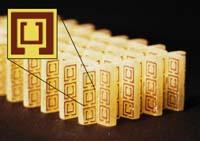Naughty light

Basic but of great importance. Light acts like this on any transparent object and anyone working with the light should take into account the effect. The light refracts. But it does not refract the same in all materials; if oil is placed in the place of water, it seems that the pencil is still broken, but the angle of inclination is not the same in both cases. There are materials that cause to light a greater angle than others, a different refraction. Physicists use the refractive index to express it: the higher the number, the more the direction of light tilts the material.
And, of course, the lower the refractive index, the less the direction of light worsens. But where is the limit? The index of material not able to tilt the light will be zero. But the zero value does not have to be a limit, at least in theoretical physics. Zero is not a limit, but the beginning of the negative number field. This idea can be applied to the refractive index, is there no material with negative refractive index? It would be a material that tilts the light to the other side.
Negative index

Upon entering a material with a negative refractive index, the rays instead of advancing in the direction of light, backed back. These materials were sought and found. Or rather, they did.
They had to understand the relationship between light and matter. There are materials that allow the passage of light --glass, water or air- and other non-wood, milk or water vapor. Some materials are transparent and others opaque. (And others are intermediate because they let part of the light pass through.) The question is why that happens.
Light is an electromagnetic wave. This means that it has two components: an electric field and a magnetic field. Letting these two areas pass is letting the light pass. There is the key.
They are two characteristics: the electric field on one side and the magnetic field on the other. The question is how easily each of them goes through the material. Physicists use two parameters that measure it: electrical permittivity and magnetic permeability, respectively.

The same goes for magnetic permeability. This parameter represents the response of a material to a magnetic field. If it is positive, the magnetic response is aligned with the field, that is, it is placed in the direction and direction according to the field, and if it is negative in the direction of the field, but in the opposite direction.
A little math
Taking these two parameters into account, you understand what happens to light when you encounter a material. The refractive index can be easily calculated from these two parameters using the following simple formula: n = www.euskaltel.com

The symbols n,{ y ã, express the refractive index, electrical permittivity and magnetic permeability, respectively.
The formula is simple, it is the square root of a product, where the key to the variations of the index is found. When the square root gives a real number, the refractive index can be positive or negative; and when the square root gives an imaginary number, the refractive index concept makes no sense, that is, that material is opaque.
In short, from the point of view of the symbols of both parameters, there are four options, since these are two parameters and each parameter can be positive or negative. However, as for light response, materials can be classified into three groups.

The elements included in the second group have a single positive parameter, the other is negative. It can be permissible or permeable, it does not matter. Being a negative, mathematically, refractive index is the square root of a negative number. This has no physical meaning and, in fact, that material is opaque, does not let the light pass. Of course, nature is full of these materials. Silver, gold and many other metals have negative permittivity and positive permeability. They are opaque.
In the materials of the last group, both parameters are negative, permissible and permeable. In short, they present a "reverse" behavior with electric and magnetic fields. Both. For these materials, the root with physical meaning, the refractive index, is negative. In these materials the light, so to speak, turns back. The problem is that such materials are not found in nature. But they have been done artificially, they are metamaterials.
Metamaterials

Today they exist, but until recently they were only an ancient theoretical concept. Absence of materials in nature with electrical permittivity and negative magnetic permeability.
In 1968, the Russian physicist Victor Veselago announced the behavior of these materials if they exist. He predicted the concept of negative refractive index. However, I did not know how these materials could be made. The British John Pendry made a proposal in 2000.
Pendry's idea was to join two unclosed copper rings, one inside the other and united by a conductive thread. It is a two-dimensional structure, but if many of your copies are organized into a three-dimensional network, the result can be a metamaterial. Allows and negative permeability. The idea was from John Pendry, the material they produced at the University of California, in San Diego, and they were able to confirm that Veselago's predictions take place in reality.
In practice, what?

However, the results are not bad. One example: they claim that perfect lenses can be made. Perfect lenses would do what conventional lenses do, but without causing the aberration of light. They would be flat and thin lenses, as they would not need curves to drive the beam of light. Therefore, very light weights could be made, which is a revolution in the world of glasses, telescopes, etc. Of course, to do this you have to look for metamaterials that work with visible light.






